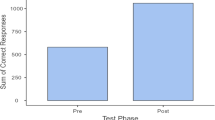Abstract
This 3-stage intervention study enrolled all adult patients referred to a universitybased emergency department (ED) during randomly assigned 1-week preeducation or posteducation periods. Triage decisions recorded by ED paramedics (n=8) both before and after an educational training session were compared to decisions made by emergency physicians (EPs). Triage decisions of paramedics and EPs in the preeducation phase showed poor consistency (κ =0.317, κ=0.388). Triage decisions in the posteducation phase increased slightly but were still found to be low. On the other hand, consistency between the triage assessments recorded by paramedics and EPs of the general appearance of patients increased from low in the preeducation phase to moderate in the posteducation phase (κ =0.327, κ=0.500, respectively). The training session was associated with a slight increase in the consistency of triage decisions recorded by paramedics and EPs.
Similar content being viewed by others
References
Williams B, Read S, Glascow J, Potter T. Piloting an evaluation of triage.Int J Nurs. 1992;29: 275–288.
Berner AR. Triage. In: Harwood-Nuss AL, Linden CH, fnLuten RC, Shepherd SM, Wolfson AB, eds.The Clinical Practice of Emergency Medicine. 2nd ed. Philadelphia, Pa: Lippincott-Raven; 1996:1525-1527.
Williams RM. Triage and emergency department services.Ann Emerg Med. 1996;27:506–508.
Burgess K. A dynamic role that improves the service: combining triage and nurse practitioner roles in A&E.Prof Nurse. 1992;7:301–303.
Somerson SW, Markovchick VJ. Development of the triage system. In: Salluzzo RF, Mayer TA, Strauss RW, Kidd P, eds.Emergency Department Management Principles and Applications. 2nd ed. St Louis, Mo: Mosby; 1997:179–192.
Wong TW, Tseng G, Lee LW. Report of an audit of nurse triage in an accident and emergency department.J Accid Emerg Med. 1994;11:91–95.
Kaplan LJ, Santora TA, Blank-Reid CA, Trooskin SZ. Improved emergency department efficiency with a three-tier trauma triage system.Injury. 1997;28:449–453.
Derlet R. Triage [eMedicine.com Web site]. Available at: http://www.emedicine.com/emerg/ topic670.htm. Accessed September 4, 2004.
Hay E, Bekerman L, Rosenberg G, Peled R. Quality assurance of nurse triage: consistency of results over three years.Am J Emerg Med. 2001;19:113–117.
Waldrop RD, Harper DE, Mandry C. Prospective assessment of triage in an urban emergency department.South Med J. 1997;90:1208–1212.
Fernandes CM, Wuerz R, Clark S, Djurdjev O. How reliable is emergency department triage?Ann Emerg Med. 1999;34:141–147.
Reilly BM, Evans AT, Schaider JJ, Wang Y. Triage of patients with chest pain in the emergency department: a comparative study of physicians’ decisions.Am J Med. 2002;1:95–103.
Pearson SD, Goldman L, Garcia TB, Cook EF, Lee TH. Physician response to a prediction rule for the triage of emergency department patients with chest pain.J Gen Intern Med. 1994;9: 241–247.
Author information
Authors and Affiliations
Rights and permissions
About this article
Cite this article
Sarikaya, S., Soysal, S., Karcioglu, O. et al. Paramedics and triage: Effect of one training session on triage in the emergency department. Adv Therapy 21, 329–334 (2004). https://doi.org/10.1007/BF02850037
Issue Date:
DOI: https://doi.org/10.1007/BF02850037




